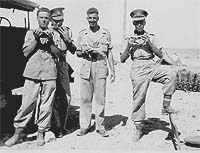RMP 203 PROVOST COY 1953
STABILIZING THE BORDER BETWEEN JORDAN
& ISRAEL
As Remembered By Walter Ray Davies
It was mid summer 1952 and I was a lance corporal in the RMP,
203 Provost Coy, Moascar Garrison, when about a dozen of us MP’s were
told we had been assigned to join an army being sent to Trans-Jordan to pacify
the border between it and Israel. We were allocated vehicles, jeeps and one
tonners, and headed off to Suez. There we drove onto the LST “Evan Gibb”
and secured the vehicles for the journey down the Gulf of Suez and up the Gulf
of Aqaba. Unfortunately the LST engine broke down enroute and we drifted for
two days until engine parts were delivered and installed. There was only enough
water on board for the 2 to 3 days the journey was supposed to take, so, being
MP’s, we were given the job of guarding the water tank and minimising
its use.
One night there was a dramatic dry electrical storm with lightning flashing
every which way across the sky, it certainly made one appreciate the fear that
people in ancient time had of ‘lightning bolts’. Arriving in Aquaba
we bivouacked near the beach and had a great couple of days swimming and laying
around. The water was crystal clear and the bottom, 30 to 40 feet, showed up
in every detail. Our requiem was rudely shattered when four of us were detailed
to look for a deserter who, being Jewish, was thought to be climbing over the
mountain towards Israel. The mountains there are as if a giant had tipped over
a wheelbarrow of racks and as we climbed rocks would slip and tumble down on
anyone below. As we rested at the top of the mountain, we watched the goat herders
tending their flock and running like goats themselves up and down over the rocks.
Needless to say we didn’t catch the deserter.
The next day the army was ready to move and it took off across the desert along
the same route, although in the reverse direction, that Lawrence of Arabia took
when he attacked Aqaba. We were employed to trail the army and look for broken
down vehicles, radio in their position to the REME, and guide any that were
lost. That proved to be a laugh because we got lost ourselves. It was dusk when
we stumbled upon a village, Ma’an, and the children in the street immediately
picked up stones and pelted us with them. Hot footing it out of the village
we saw on the horizon a bright light and knew it was the convoy, never was a
sight more welcome!
The next few days the convoy proceeded north spread out over the desert which
was rocky and covered with a layer of dust at least an inch thick. This resulted
in dust being thrown up and it was like driving in a London ‘peasouper
– suddenly a stalled truck would appear just in front of you and there
was only a couple of seconds to stop. A few days later the terrain changed to
very hilly and vehicles had to traverse steep hillsides covered with loose rocks
and a steep fall on one side inside the valley. As a jeep driver I was constantly
scared that the jeep wouldn’t make it and I would end up going over a
cliff, so I can’t imagine how the drivers of the 10 tonners were feeling.
To my knowledge, only one 10 tonner crashed. We eventually arrived at the border
with Syria and the army bivouacked near Al Mafraq where an RAF base had been
established many years previously. Wonder of wonders – they let us use
their showere block and it was great to wash off 2 weeks of dust and grime.
The following few weeks we were employed in the laying out of routes between
various regiments and taking part in 24 hour guard duty. During this time many
soldiers went down with ‘Gypo-belly’, dysentery, and I was one of
them. I either lay in my tent, doubled up, wishing I was dead or hot footing
it to the latrine, a hole in the ground with a plank of timber supported each
end by oildrums, surrounds by hessian sacking propped up by poles. “Flies
paradise” we called it. Someone set fire to the sacking but exposure to
fresh air did nothing to reduce the pong!
Sgt Page, our squad leader, suggested four of us drive to Amman and rent a
taxi to Jerusalem, which we did, leaving the jeep with an Arab Legion detachment.
The driver was so small he could barely see over the steering wheel but he got
us to the Damascus Gate safely. There, for a few shillings, a tour guide took
us around all the sights. Anglicans dispute the Church of the Holy Sepulchre
as being the burial place of Jesus and believe another tomb close by to be the
correct one. We returned to the taxi and after a couple of minutes it became
obvious the driver was ‘as high as a kite’, hashish probably, because
he was swerving around. Jerusalem is on top of a mountain and the road in those
days was narrow and winding with sheer drops to the valley below. We forced
him to stop and Sgt Page took over and got us back to Amman safely. The Arab
Legion sergeant major in charge of the detachment invited us to his home and
we had a very nice meal of Arab cuisine. A few weeks later the politicians must
have sorted out their problems because we were suddenly ordered back to the
Canal Zone, and this time we didn’t have to go via the Red Sea but drove
back across the Sinai to comfortable beds, regular showers, half decent food
and cold beer.
|

LST Evan Gibb in Aqaba |
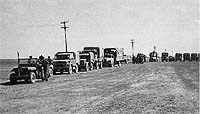
Convoy leaves Aqaba
|
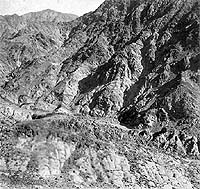
Aqaba looking down from mountain
|

'Mountaineers' don't find deserter
|
Jordy Mills, Ern Riley, Len Farrow & Self (Ray
Davies) enrout to Jordan
|
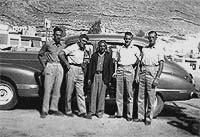
Renting a taxi in Amman
|
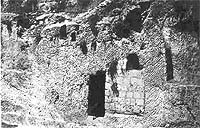
The Tomb below Calvary
|
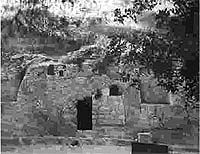
The Tomb in the Garden
|
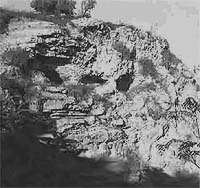
Skull Cliff - Calvery ison top
|
Back to RMP
Back to Army Units
Back to Canal Zoners
Memories
Back to Main Page




